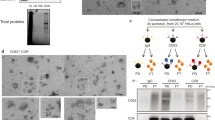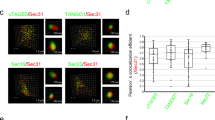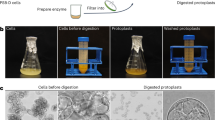Abstract
THE transport of proteins destined for post-endoplasmic reticulum locations in the secretory pathway is mediated by small vesicular carriers1–3. Transport vesicles have been generated in cell-free assays from the yeast Saccharomyces cerevisiae, and mammalian systems4–14. Yeast genes encoding cytosolic components that par-ticipate in vesicular traffic were first identified from the collection of conditional-lethal sec (secretory) mutants15–17. Mutations in the yeast SEC7 gene disrupt protein transport in the secretory pathway at the nonpermissive temperature18. The SEC7 gene product is a phosphoprotein of relative molecular mass 230,000 that functions from the cytoplasmic aspect of intracellular mem-branes19–20. We report that in a yeast cell-free transport assay, the introduction of antibodies to Sec? protein (Sec7p) results in the accumulation of transport vesicles. These vesicles are retrieved with SecTp-specific antibodies by immuno-isolation for bio-chemical and electron microscopic characterization. SecTp on the surface of the accumulated transport vesicles, in combination with previous genetic and biochemical studies18–20, implicate SecTp as part of a (non-clathrin) vesicle coat. This SecTp-containing coat structure is proposed to be essential for vesicle budding at multiple stages in the yeast secretory pathway.
This is a preview of subscription content, access via your institution
Access options
Subscribe to this journal
Receive 51 print issues and online access
$199.00 per year
only $3.90 per issue
Buy this article
- Purchase on Springer Link
- Instant access to full article PDF
Prices may be subject to local taxes which are calculated during checkout
Similar content being viewed by others
References
Warren, G. Nature 345, 382–384 (1990).
Rothman, J. E. & Orci, L. FASEB J. 4, 1460–1468 (1990).
Melançon, P., Franzusoff, A. & Howell, K. Trends Cell Biol. 114, 219–229 (1991).
Serafini, T. et al. Nature 349, 215–220 (1991).
Salamero, J., Sztul, E. S. & Howell, K. E. Proc. natn. Acad. Sci. U.S.A. 87, 7717–7721 (1990).
Tooze, S. & Huttner, W. B. Cell 60, 837–847 (1990).
deCurtis, I. & Simons, K. Cell 58, 719–727 (1989).
Balch, W. E. Trends biochem. Sci. 15, 473–477 (1990).
Paulik, M., Nowack, D. D. & Morré, D. J. J. biol. Chem. 263, 17738–17748 (1988).
Lodish, H. F., Kong, N., Hirani, S. & Rasmussen, J. J. Cell Biol. 104, 221–230 (1987).
Groesch, M. E., Ruohola, H., Bacon, R., Rossi, G. & Ferro-Novick, S. J. Cell Biol. 111, 45–53 (1990).
Rexach, M., & Schekman, R. J. Cell Biol. 114, 219–229 (1991).
Baker, D., Wuestehube, L., Schekman, R., Botstein, D. & Segev, N. Proc. natn. Acad. Sci. U.S.A. 87, 355–359 (1990).
Segev, N. Science 252, 1553–1556 (1991).
Kaiser, C. A. & Schekman, R. Cell 61, 723–733 (1990).
Newman, A. P. & Ferro-Novick, S. J. Cell Biol. 105, 1587–1594 (1987).
Novick, P., Field, C. & Schekman, R. Cell 21, 205–215 (1980).
Franzusoff, A. & Schekman, R. EMB0 J. 8, 2695–2702 (1989).
Achstetter, T., Franzusoff, A., Field, C. & Schekman, R. J. biol. Chem. 263, 11711–11717 (1988).
Franzusoff, A., Redding, K. R., Crosby, J., Fuller, R. S. & Schekman, R. J. Cell Biol. 112, 27–37 (1991).
Baker, D., Hicke, L., Rexach, M., Schleyer, M. & Schekman, R. Cell 54, 335–344 (1988).
Ruohola, H., Kabcenell, A. K. & Ferro-Novick, S. J. Cell Biol. 107, 1465–1476 (1988).
Wright, R., Basson, M., D'Ari, L. & Rine, J. J. Cell Biol. 107, 101–114 (1988).
Deshaies, R. J., Sanders, S. L., Feldheim, D. A. & Schekman, R. Nature 349, 806–808 (1991).
Malhotra, V., Serafini, T., Orci, L., Shepherd, J. C. & Rothman, J. E. Cell 58, 329–336 (1989).
Novick, P., Ferro, S. & Schekman, R. Cell 25, 461–469 (1981).
Howell, K. E., Schmid, R., Ugelstad, J. & Gruenberg, J. Meth. Cell Biol. 31, 265–292 (1989).
Author information
Authors and Affiliations
Rights and permissions
About this article
Cite this article
Franzusoff, A., Lauz, E. & Howell, K. Immuno-isolation of Sec7p-coated transport vesicles from the yeast secretory pathway. Nature 355, 173–175 (1992). https://doi.org/10.1038/355173a0
Received:
Accepted:
Issue Date:
DOI: https://doi.org/10.1038/355173a0
This article is cited by
-
Membrane stress is coupled to a rapid translational control of gene expression in chlorpromazine-treated cells
Current Genetics (2007)
-
Nucleotide exchange on ARF mediated by yeast Geal protein
Nature (1996)
-
Transport of proteins in eukaryotic cells: more questions ahead
Plant Molecular Biology (1996)
Comments
By submitting a comment you agree to abide by our Terms and Community Guidelines. If you find something abusive or that does not comply with our terms or guidelines please flag it as inappropriate.



